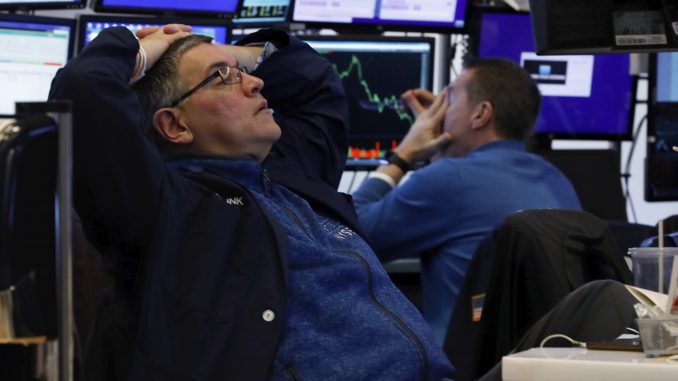
NEW YORK — The escalating coronavirus emergency Thursday sent stocks to their worst losses since the Black Monday crash of 1987, extending a sell-off that has now wiped out most of Wall Street’s big run-up since President Donald Trump’s election.
The S&P 500 plummeted 9.5%, for a total drop of 26.7% from its all-time high, set just last month. That puts it way past the 20% threshold to make this a bear market, snapping an unprecedented, nearly 11-year bull-market run. The Dow Jones Industrial Average sank 10% for its worst day since a nearly 23% drop on Oct. 19, 1987.
European markets lost 12% in one of their worst days ever, even after the European Central Bank pledged to buy more bonds and offer more help for the economy.
The heavy losses came amid a cascade of cancellations and shutdowns across the globe — including Trump’s suspension of most travel to the U.S. from Europe — and rising worries that the White House and other authorities around the world can’t or won’t counter the economic damage from the coronavirus pandemic any time soon.
“The news just continues to get worse, and the travel ban puts an exclamation point on the weakness we’re going to see in global GDP and, in turn, the U.S.,” said Liz Ann Sonders, chief investment strategist at Charles Schwab. “We’re starting to get a sense of how dire the impact on the economy is going to be. Each day the news doesn’t get better, it gets worse. It’s now has hit Main Street to a more significant degree.”
Stocks fell so fast on Wall Street at the opening bell that they triggered an automatic, 15-minute trading halt for the second time this week. The so-called circuit breakers were first adopted after the 1987 crash, and until this week hadn’t been tripped since 1997.
The Dow briefly turned upward and halved its losses at one point in the afternoon after the Federal Reserve announced it would step in to ease “highly unusual disruptions” in the Treasury market. But the burst of momentum quickly faded.
Trump often points proudly to the big rise on Wall Street under his administration and warned a crowd at a rally last August that “whether you love me or hate, you gotta vote for me,” or else your 401(k) will go “down the tubes.”
Just last month, the Dow was boasting a nearly 50% gain since Trump took the oath of office on Jan. 20, 2017. By Thursday’s close, the Dow was clinging to a 6.9% gain, though it was still up nearly 16% since just before Trump’s election in November 2016.
On Wednesday, the Dow finished the day down more than 20% from its all-time high, set just last month, officially entering what is known as a bear market for the first time in over a decade.
The combined health crisis and retreat on Wall Street heightened fears of a recession.
“This is bad. The worst and fastest stock market correction in our career,” Chris Rupkey, chief financial economist at MUFG Union, said in a research note overnight. “The economy is doomed to recession if the country stops working and takes the next 30 days off. The stock market knows it.”
The coronavirus has infected around 128,000 people worldwide and killed over 4,700. The death toll in the U.S. climbed to 39, with over 1,300 infections. For most people, the virus causes only mild or moderate symptoms, such as fever and cough. For some, especially older adults and people with existing health problems, it can cause more severe illnesses, including pneumonia. The vast majority of people recover from the virus in a matter of weeks.
In a somber prime-time address Wednesday night from the White House, Trump announced the new travel ban as well as measures to extend loans, payroll tax cuts and other financial relief to individuals and businesses hurt by the crisis.
But the travel restrictions represented another heavy blow to the already battered airline and travel industries, and the other measures did not impress Wall Street.
The market damage was worldwide and eye-popping. Among the big moves:
— Travel stocks again were among the hardest hit. Norwegian Cruise Line and Royal Caribbean Cruises both lost roughly a quarter of their value. Another drop for United Airlines put its loss for the year at more than 50%.
— Oil continued its brutal week, with benchmark U.S. at $31 per barrel.
Perhaps more alarming were complaints in recent days by investors that trading in the Treasury market wasn’t working well. For reasons that weren’t immediately clear, traders said they were seeing surprisingly large gaps in prices being offered by buyers and sellers. That threatened to cause the market to seize up.
In a surprise move, the Fed said it would pump in at least $1.5 trillion to help calm the market and facilitate trading.
After earlier thinking that the virus could remain mostly in China and that any dip in the economy would be followed by a quick rebound, investors are seeing the damage and disruptions mount, with Italy locking itself down, the NBA suspending games and authorities in the U.S. and beyond banning large gatherings and closing schools.
